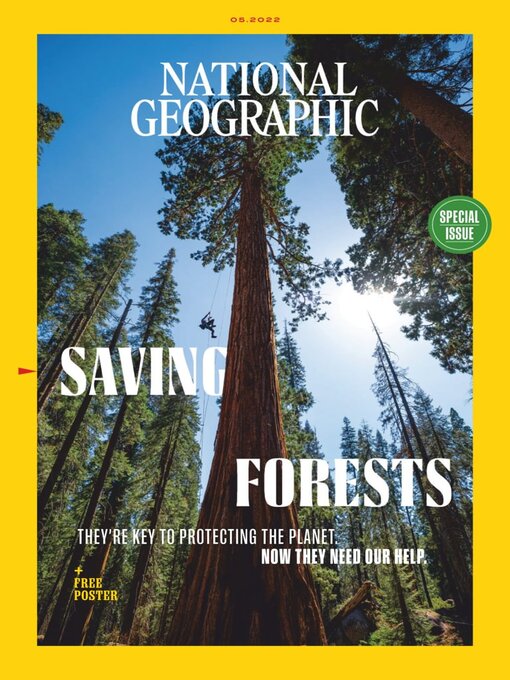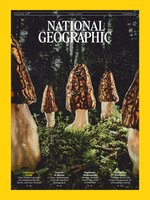Amazing discoveries and experiences await you in every issue of National Geographic magazine. The latest news in science, exploration, and culture will open your eyes to the world’s many wonders.
FORESTS, FOR LIFE • Today, forests (shaded green on this map) cover one-third of Earth’s land surface, more than 15.6 million square miles. Each year, forests and other vegetation absorb up to a third of the CO2 released from burning fossil fuels.
STILL STANDING TALL • A Norway-based photographer ventures into the woods to document the beauty, value, and fragility of Europe’s old-growth forests.
THE BACKSTORY • OLD-GROWTH FORESTS ARE EUROPE’S NATURAL HERITAGE. MOST ARE PROTECTED, BUT ARE THEY SAFE?
LIVES DEPEND ON FORESTS • AMID TREES MARKED FOR FELLING, A SCIENTIST SPELLS OUT FORESTS’ VITAL ROLE IN SAVING WILDLIFE, HUMANITY, AND A WARMING PLANET.
THE ‘WOOD-WIDE WEB,’ EXPLAINED
BREAK THROUGHS • DISPATCHES FROM THE FRONT LINES OF SCIENCE AND INNOVATION
CENTURIES-OLD SURVIVORS • IN THE LATE 1800S AND EARLY 1900S, LOGGERS CLEAR-CUT PINES IN MINNESOTA’S NORTH WOODS—BUT SOME REMAIN, THANKS TO A MAPPING ERROR.
From trees, a new way to pinpoint earthquakes
THE FIRST FORESTS • Researchers in China have discovered fossils of the oldest forest ever found in Asia, a 62-acre stand dating back some 365 million years. The newly unearthed genus, named Guangdedendron, lived when trees were starting to put down roots around the world. The rise of forests permanently altered Earth’s atmosphere and climate.
Kingdoms of the Dadanites and Lihyanites • Distant view of tombs at Dadan.
PLANET POSSIBLE • Stroll a canopy walkway, take a tree-climbing class, find forest lodgings, play leaf detective. You too can be an ‘arbornaut.’
PHANTOM IN THE FOREST • IT’S AN EVERGREEN THAT’S WHITE. IT LIVES LIKE A MOOCHER AND LOOKS LIKE A GHOST. THE ALBINO REDWOOD IS A GENETIC MARVEL, WRAPPED IN MYSTERY.
The Future of Forests • HEAT AND DROUGHT ARE KILLING OUR FORESTS. BUT WE CAN LIMIT THE DAMAGE— IF WE CHANGE COURSE NOW.
ROOTS OF A CRISIS • As temperatures rise because of climate change, trees are being hit with heat waves and drought, killing them or weakening their resistance to a cascade of pressures, from pests to rising sea levels.
WORLDWIDE LOSSES • Trees are facing unprecedented mortality events around the globe. These die-offs are projected to accelerate as more frequent and severe droughts and heat waves push trees—especially old-growth forests that matured under bygone conditions—beyond their threshold of survivability.
FIGHTING FIRE WITH FIRE • AUSTRALIA’S ABORIGINAL PEOPLE HAVE REVIVED THE ANCIENT PRACTICE OF PLANNED BURNING TO PRESERVE AND RENEW THEIR HOMELANDS—AND HELP SUPPORT THEIR COMMUNITIES.
HARNESSING THE FLAMES • For tens of thousands of years, Australia’s Aboriginal people used fire to prevent out-of-control wildfires. Today, after many returned to their northern Australia homelands in the 1970s, that practice has been revived. Setting small, strategically planned blazes using drip torches and incendiary pellets dropped from helicopters, Indigenous rangers create patches of burned savanna that act as firebreaks. Over the past two decades, the total area burned by fire in western Arnhem Land has diminished significantly.
A FRAGILE REFUGE FOR FOREST ELEPHANTS • IN A REMOTE FOREST IN GABON, WARMER NIGHTS AND LESS RAINFALL MAY BE CAUSING TREES TO GROW LESS FRUIT, THREATENING ONE OF AFRICA’S MOST ENDANGERED ANIMALS.
GARDENERS OF GABON • Forest elephants are key ecosystem engineers in Africa’s tropical rainforests. More than a dozen tree species in the region rely on the animals to disperse seeds through their dung. The elephants, in turn, depend on the highly nutritious fruit for their diet. But...

 Jan 01 2026
Jan 01 2026
 Dec 01 2025
Dec 01 2025
 Nov 01 2025
Nov 01 2025
 Oct 01 2025
Oct 01 2025
 Sep 01 2025
Sep 01 2025
 Aug 01 2025
Aug 01 2025
 Jul 01 2025
Jul 01 2025
 Jun 01 2025
Jun 01 2025
 May 01 2025
May 01 2025
 Apr 01 2025
Apr 01 2025
 Mar 01 2025
Mar 01 2025
 Feb 01 2025
Feb 01 2025
 Jan 01 2025
Jan 01 2025
 Dec 01 2024
Dec 01 2024
 Nov 01 2024
Nov 01 2024
 Oct 01 2024
Oct 01 2024
 Sep 01 2024
Sep 01 2024
 Aug 01 2024
Aug 01 2024
 Jul 01 2024
Jul 01 2024
 Jun 01 2024
Jun 01 2024
 May 01 2024
May 01 2024
 Apr 01 2024
Apr 01 2024
 Mar 01 2024
Mar 01 2024
 Feb 01 2024
Feb 01 2024